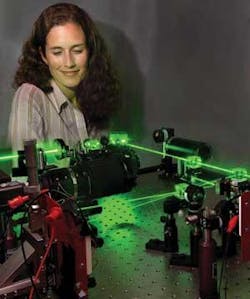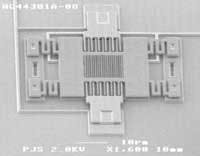Nanophotonics: Near-field optics yield nanoscale motion sensor
A subwavelength grating and variable reflector proposed by researchers at Sandia National Laboratories (Albuquerque, NM) last year (see Laser Focus World, December 2003, p. 13) has been fabricated and demonstrated as a laterally deformable optical nanoelectromechanical system that enables unaided visual observation of translational motion on the order of 10 nm, according to Dustin Carr, who led the research team.1, 2 Team member Bianca Keeler, who presented the results in October as an invited paper at the SPIE Optics East meeting in Philadelphia, is shown observing the system in operation using an eye-safe laser and low-light-level photography (see above).
The actual grating transducer at the heart of the system consists of two vertically juxtaposed subwavelength gratings fabricated in silicon and separated by a 300-nm air gap. The lower grating is fixed, while the upper one can move both laterally and vertically. When illuminated by a normal-incidence laser beam, slight amounts of relative motion between the two gratings produce large changes in optical reflection amplitude due to near-field optical effects. In this experiment, the upper grating was about 30 × 30 µm with a period of 720 nm (see below). Electrostatic actuation of the transducer was enabled vertically by parallel-plate electrodes in the lower plane, and laterally by comb-drive fingers.The polysilicon device was fabricated in four photolithographic steps using a 248-nm lithography tool to achieve feature dimensions on the order of 0.2 to 0.4 µm. Unlike the small semiconductor feature sizes for which such tools were developed, Carr noted, miniaturization in this case was not driven by economies of scale. “Our device couldn’t exist if you didn’t make it this small,” he said. Under 532-nm illumination, the relatively slight (10- to 100-nm) range of linear motion in the transducer produced changes in the intensity of the reflected signal on the order of 25%, normalized to peak reflectance. An 8-kHz voltage drive in the lateral plane peaking at 2 mV generated a motion amplitude of 57 fm, and a detection limit of 10 fm/Hz1/2 was observed. The sensitivity of the device might be further increased by optimizing the design and by illuminating it with plane waves rather than a focused beam, Keeler said.
“If these were made small, synchronized, cheap, and placed on every block, we could take data from all of theses sensors at once and measure the motion of the Earth when there’s not an earthquake,” Carr said. “So we could learn what leads up to one.” Given a three- to five-year time frame before the devices are available for use, other potential applications range from military defense to skid and traction control on automobiles. While motion-detection sensitivity is comparable to MEMS (microelectromechanical systems) transducers, the optical device also offers high immunity to electromagnetic interference and the possibility of integration with fiberoptics to create a sensor network, Keeler said.
Carr’s team plans to use the device to explore both the fundamental science of molecular forces and the practical application of inertial navigation, which currently requires large gyroscopes to keep commercial airplanes moving on a preset course. “We could have hand-held-sized devices on Volkswagens that would work even in a tunnel,” Carr said.
REFERENCES
- D. W. Carr et al., Optics Letters 28(18) 1636 (Sept. 15, 2003).
- B. E. N. Keeler et al., Optics Letters 29(11) 1182 (June 1, 2004).
Hassaun A. Jones-Bey | Senior Editor and Freelance Writer
Hassaun A. Jones-Bey was a senior editor and then freelance writer for Laser Focus World.

